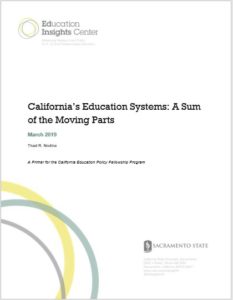
We commissioned this working paper for the California Education Policy Fellowship Program (EPFP) because we had a hard time finding one current source that integrates major imperatives and initiatives in all of California’s public education systems, K-16. We intend for this paper to provide a baseline of information for Fellows, and to be provocative and generate discussion within the program. Thad wrote the paper for EPFP’s inaugural year in 2016-17 and updated it annually, based on feedback from Fellows.
In addition to sparking conversations within EPFP, we think it is important to have a document that provides context for the state’s major education reforms—and that makes sense of them with regard to their potential effects on students across systems. California’s K-12 and higher education systems are undertaking some of the most ambitious education reform experiments in the country. These include:
- In K-12 schools: the Local Control Funding Formula, Common Core Standards, Next Generation Science Standards, the California Assessment of Student Performance and Progress, and a new accountability system.
- In the California Community Colleges: the Student Equity and Achievement Program (which integrates the Basic Skills Initiative, the Student Equity program, and the Student Success and Support Program), the Institutional Effectiveness Partnership Initiative, Guided Pathways, and the revamping of remedial education under AB 705.
- In the California State University (CSU): the CSU’s Graduation Initiative 2025 and its executive orders regarding the transformation of developmental education and general education.
We hope this paper will spark discussion and action in pursuit of California’s vision for its public education systems and equitable opportunities and outcomes for students.
Sincerely,
The EPFP team

This work is licensed under a Creative Commons Attribution-NonCommercial 4.0 International License.

